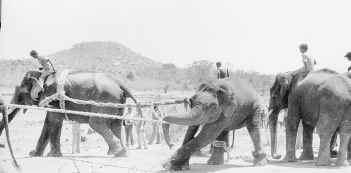More than a hundred elephants were reported to have escaped from the forest into the coffee estates nearby. The incident made news only when coffee planters issued an ultimatum to the Government threatening to hunt down the elephants if it did not take measures to contain the elephants in the forests. Pre-monsoon rains have been below normal this year too and have not improved the fodder and water availability to any great extent in the forests. This is obviously the time for forest conservation and afforestation efforts should be the preoccupation of the Government. However, land owners in Kodagu to make up for the low coffee prices are demanding proprietary rights over trees occurring on their lands. They question the discriminatory policies of Karnataka Government in giving absolute rights over trees to land owners all over the State except in Kodagu and demand uniform laws throughout the State. According to them, felling of trees is allowed everywhere including in the fragile Western Ghat districts where land owners pay only a small percentage as valuation to the Government on the trees they cut. In Kodagu, however, the landowners have been paying 55 per cent of the value of trees as valuation to the forest department. People expect accountability from the forest department for the crores it collects every year as valuation from the sale of timber through its various auction centres. They say even if a fraction of that revenue had been spent wisely in the development of local forests by planting the right kind of species of trees and digging water holes for animals in the forests, the elephants would not venture into human settlements. The laws relating to cutting of trees on private lands in Kodagu are complex. It has to do with the complicated land tenure system in existence in the district. Several types of tenures existed under the Rajas, later under the British, which continue to the present day. The lands, under the jamma system of tenure, were communally owned by the members of okka or a clan, while individual members of the okka exercised proprietary rights over their share of the land subject to certain conditions. The okka elder or pattedar functioned not only as the head of the clan but also as an intermediary between nuclear families and the government and facilitated collection of land assessment. The pattedar had the power to permit or reject requests for tree cutting by okka members. His clout with the Government often led to abuse of his authority when, for example, he availed credit by mortgaging the land of clan members or harassing individual members by refusing permission to cut trees for simple family needs. Such practical problems in communal ownership are often overlooked by environmentalists who romanticise communal ownership. Until the late 1980s, jamma holders faced difficulties because lands could not be sold outside the clan and jamma holders could not even avail agricultural credit from the banks. Ideally, the Government should have after a careful study brought about some reforms but since it did not, ad hoc changes in the system were made from time to time to suit short-term requirements of revenue administration. Changes were also made by politically influential jamma holders with the connivance of revenue officials, tampering with the system to such an extent that the original system was rendered unrecognisable. Legal loopholes were used to enable individual members to buy and sell jamma by conversion to sagu land, which could be bought and sold. Once this was achieved the same legal system was used to justify the practice by referring to earlier precedents! The government became a party to such property transactions by its acceptance of stamp duty on the registration of land deeds. The present controversy over tree rights is a direct result of the changes brought about in the revenue administration. Two years ago, the State Government introduced a uniform system of records and has done away with the culture specific jamabandi in Kodagu. Uniform land record system facilitates easier revenue administration by enabling computerisation of land records but doing away with the old systems throws up other problems. The culture and local eco-system specific tenure systems that had evolved over time had guaranteed the protection of the local environment even though it created problems for jamma holders. Uniform tenure system now being implemented does simplify land transactions and the jamma holders are naturally happy because uniformity bestows absolute proprietory rights on what was once communally owned land. The Government recognises defects in its policy but is rightly concerned about the consequences of conferring absolute rights over trees to land owners in ecologically sensitive areas. It would be disastrous to give absolute tree rights when rainfall is below normal and drought conditions still prevail. Kodagu is the main catchment area of the Cauvery and cutting trees in large numbers even on private lands would have serious environmental consequences. Stabilisation of agricultural commodity prices is the best way to sustain farming communities and prevent the destruction of environment for short-term financial gains. It is also necessary to evolve policies that allow landowners to earn income through cutting and selling overgrown trees by linking it to compensatory planting. Incentives including subsidies for the protection of trees on their lands could be provided for landowners thus encouraging their conservation efforts. |
